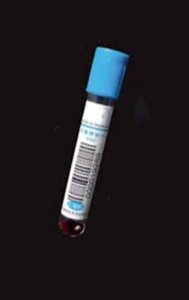Ron Hines DVM PhD
 See What Normal Blood & Urine Values Are
See What Normal Blood & Urine Values Are
 Causes Of Most Abnormal Blood & Urine Tests
Causes Of Most Abnormal Blood & Urine Tests
The Fibrinogen Level Of Your Dog Or Cat’s Blood
When your veterinarian requests a fibrinogen level on your pet, it is usually as part of a blood clotting panel that was ordered because of concerns about uncontrolled bleeding, possible genetic tendencies of your pet to bleed or a planned major surgery.
Fibrinogen is a protein found in your dog or cat’s blood. It is produced in your pet’s liver. When it is converted to fibrin, it forms the basic structural element of blood clots.
Because of fibrinogen’s importance in the clotting mechanism, your veterinarian might order the test if he/she is suspicious that your pet is bleeding due to a lack of fibrinogen.
Sometimes, you and your veterinarian are faced with unexplained anemia in your dog or cat. Because the clotting of blood is such a complex process (the coagulation cascade) with many different stages and the interplay of many chemicals and cells; a series of tests might be required to determine exactly what is wrong. The other tests that might be ordered to sort things out are a thrombocyte count, prothrombin time (PT), partial thromboplastin time (PTT), the d-dimer test the thrombin clot time TCT or an aPTT assay.
Reasons Why Your Pet’s Blood Fibrinogen Level Might Be High:
All Inflammatory diseases or those that cause tissue damage stimulating the production of inflammatory cytokines can cause your pet’s blood fibrinogen levels to rise (fibrinogen is an “acute phase reactant“). The cause could be a serious infection, severe gum and tooth disease, certain cancers, heart disease, severe arthritis, chronic kidney disease, etc. It might also be high after the trauma of a car accident.
Mid-to-late pregnancy or the advanced age of your pet can also cause your pet’s blood fibrinogen levels to rise.
In emergency situations, these pets can be given substantial amounts of intravenous fluid. That additional liquid dilutes the amount of fibrinogen in their blood and can lower fibrinogen readings.
Reasons Why Your Pet’s Blood Fibrinogen Level Might Be Low:
Disseminated Intravascular Coagulation (DIC), severe hemorrhage, liver failure, inherited genetic deficiencies in fibrinogen production (e.g. hypofibrinogenaemia) can all caused reduced blood fibrinogen levels.
Liver disease, so advanced that the pet’s liver can no longer manufacture fibrinogen, or severe malnutrition can also be the cause of low fibrinogen levels.
The test’s fibrinogen level results can also falsely decrease if a lavender top collection tube (EDTA tube) sat over 24 hrs before testing was performed.
Complementary Tests:
aPTT (Activated Partial Thromboplastin Time) or prothrombin time (PT), thrombin clot time (TCT)
DxMe
You are on the Vetspace animal health website
 Visiting the products that you see displayed on this website help me pay the cost of keeping these articles on the Internet.
Visiting the products that you see displayed on this website help me pay the cost of keeping these articles on the Internet.


